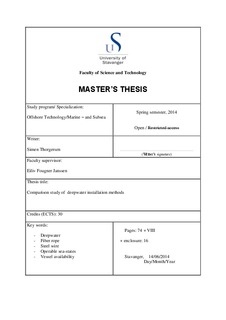| dc.contributor.author | Thorgersen, Simen | |
| dc.date.accessioned | 2014-09-15T07:38:59Z | |
| dc.date.available | 2014-09-15T07:38:59Z | |
| dc.date.issued | 2014-06-16 | |
| dc.identifier.uri | http://hdl.handle.net/11250/219679 | |
| dc.description | Master's thesis in Offshore technology | nb_NO |
| dc.description.abstract | The combination of deeper offshore field developments and larger, more complex subsea structures results in new requirements and challenges for installation vessels and related deployment systems. The conventional vertical deployment system, utilizing steel wire as lifting line, is struggling to meet the industries requirement of installing heavy subsea structures in water depths exceeding 2000m.
The objective of this thesis is to find a viable solution to the challenges met during deepwater installation of subsea structures, and to possibly reduce the problem of vessel availability faced in the industry today.
This thesis considers new installation methods and assesses their applicability for deepwater installation through a state of the art review. A comparison study between a fiber rope deployment system and a conventional steel wire deployment system is conducted. The study cover all main challenges met during deepwater installation, and consider the installation of two different subsea structures.
Due to the low self-weight of fiber rope, the fiber rope deployment system is seen as applicable for deepwater installation with smaller vessels. The system is equipped with active heave compensators and constant tension function, making it applicable for overboarding and splash zone lifting. A feasibility study of deepwater installation with a smaller vessel, rigged with an A-frame and a fiber rope deployment system is conducted.
Dynamic analysis of splash zone lifting and lowering to seabed operations is performed with the modeling and analysis program ORCAFLEX. A laboratory exercise is performed to verify the ORCAFLEX model.
The fiber rope deployment system is found to be a viable substitute for the conventional steel wire system for deepwater purposes. The system solves the problem related to self-weight of steel wire and has a better weather limiting criteria for lowering to seabed operations. Positioning of the lifted object on the seabed is however found to be more challenging when utilizing fiber rope as lifting line.
The A-frame vessel rigged with a fiber rope deployment system is found to be applicable for deepwater installation of subsea structures weighing ≤ 70Te. The installation can be performed for a wide range of sea-states in deepwater regions, and problems related to vessel availability can possibly be reduced. | nb_NO |
| dc.language.iso | eng | nb_NO |
| dc.publisher | University of Stavanger, Norway | nb_NO |
| dc.relation.ispartofseries | Masteroppgave/UIS-TN-IKM/2014; | |
| dc.rights | Attribution 3.0 Norway | * |
| dc.rights.uri | http://creativecommons.org/licenses/by/3.0/no/ | * |
| dc.subject | offshore teknologi | nb_NO |
| dc.subject | undervannsteknologi | nb_NO |
| dc.subject | subsea technology | nb_NO |
| dc.subject | steel wire | nb_NO |
| dc.subject | fiber rope | nb_NO |
| dc.subject | vessel availability | nb_NO |
| dc.subject | deepwater | nb_NO |
| dc.title | Comparison study of deepwater installation methods | nb_NO |
| dc.type | Master thesis | nb_NO |
| dc.subject.nsi | VDP::Technology: 500::Marine technology: 580::Offshore technology: 581 | nb_NO |

